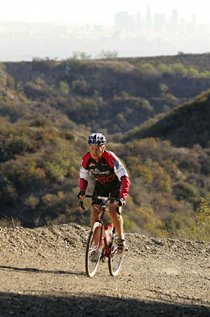As a historical note, this is the first All-Rounder sold to anyone after Rivendell was founded in 1994. As a surprise, Grant had an "extra" serial number added to the bottom bracket shell that include my initials, "AR" for All-Rounder, and "#1" because it was the first sold. The frame and fork were hand crafted by the artisans at Waterford Precision Cycles in Waterford, Wisconsin.
I didn't build this bike up, or ride it, until the fall of 1998 as it took some time to find all the parts I wanted to run on it. As soon as I assembled it, I flew to Seattle and rode from there to Mill Valley, CA in Marin County in a week. Although I primarily planned to use it off-road or for combined trail/road rides, its initial configuration was very roadie: the components you see here, but with Scott Drop-In handlebars, the 8-spd shifters mounted on the down tube, Spinergy Rev-X wheels, and V-brakes. I found those wheels flexed too much, I didn't much like the drop bars off-road, the V-brakes worked terribly and had to be run VERY close to the rims, and it was darn near impossible to reach the down-tube shifters while riding off-road. As a result, I reconfigured the bike as you see it the main slideshow below, pretty much identical to its predecessor in my stable, a 1993 Bridgestone XO-1. The "in action" shots below are from a week-long trip to Moab and The Maze in Canyonlands National Park in Utah in May 2003. I stopped riding it in about 2005, so, although it's 16 years old, it's only seen a few years of actual riding. The rest of the time, it's been indoors. Of course, I've treated the interior of the frame several times over the years with Weigle FrameSaver to protect against corrision.
In about 2008, I had it repainted in an absolutely beautiful glossy black and blue color combo by legendary bicycle painter Joe Bell. I also had a third set of water bottle braze-ons added to the underside of the down tube. (See a full set of images from that new incarnation here in the Velo Cult online museum.)
Now, three years later, I still have not built it back up after that repaint. I love this bike, it's an amazing ride, its rich in Rivendell history, and I have a deep attachment to it, but I just don't have a need for it in my stable anymore. Therefore, I passed it along to a new owner in April of 2012.
In brief, the sizing is: 54.5cm seat tube with 72.5 degree seat angle and 57.5cm top tube. The All-Rounder was designed to fit a bit smaller than the same rider's appropriate road bike size (most of my road bikes have 57cm seat tubes, for example, but the same 57.5cm top tubes.) Full geometry and spec's, dozens of photos, and lots more information, are available here.
Along with the frame and fork, I sent along the following to its new caretaker:
• 25 pages of original sales documentation, brochures, and correspondence with Rivendell about the original design and purchase of this All-Rounder
• Photocopies of Issue 0 and Issue 1 of the Rivendell Reader
• New, unused, silver color Chris King headset with Ritchey front brake cable hanger, installed
• Shimano adjustable cable guides mounted to the down-tube shifter stops
• Seat post binder bolt
• One set of used but very good Nitto Moustache handlebars
Dozens more photos, full geometry and spec's, and lots more information, are available here.









































































